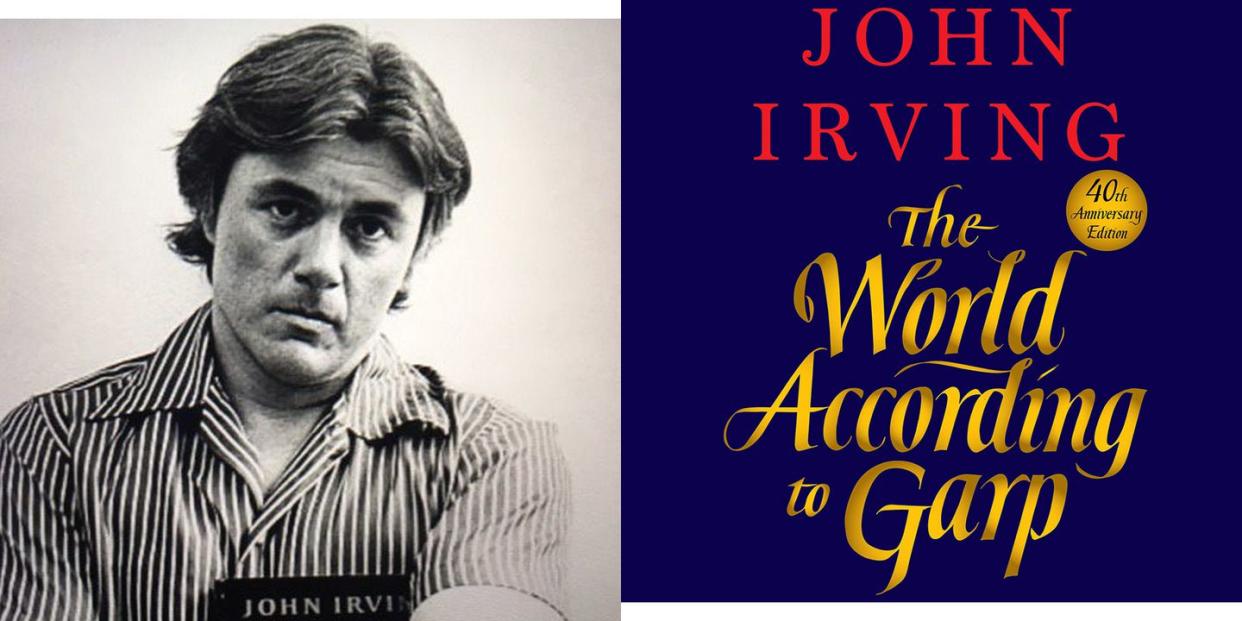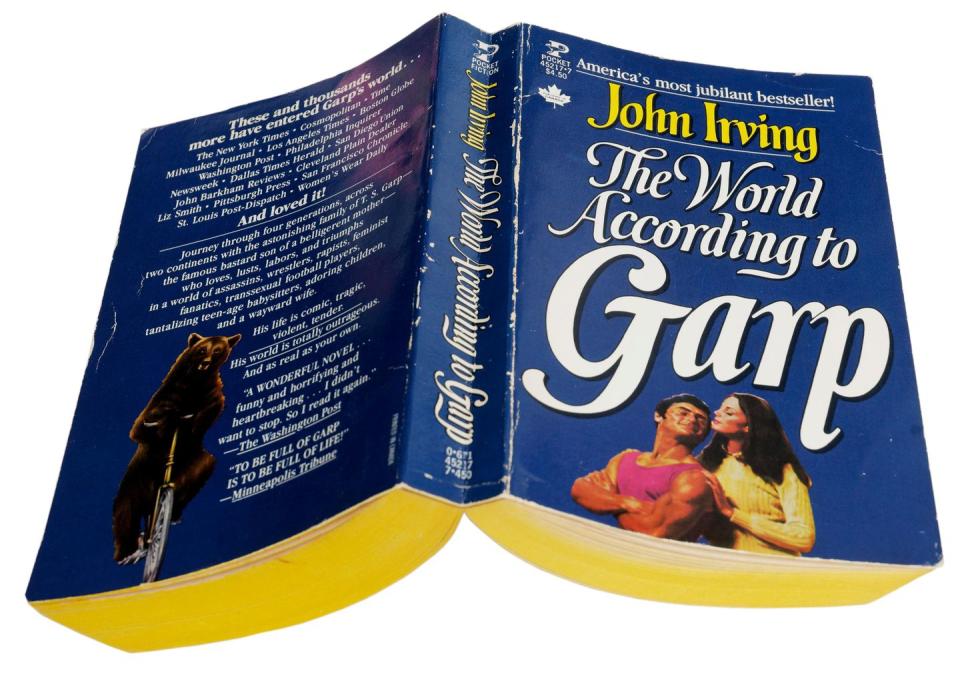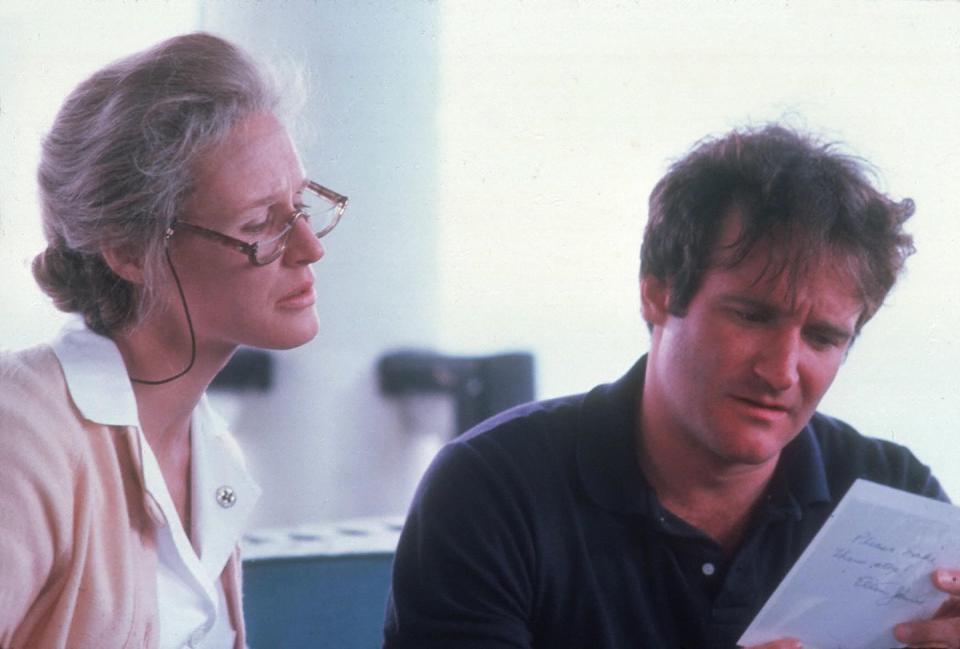'The World According to Garp' Was Never Meant to Be This Timeless


In 1978, John Irving published his fourth novel-the one that became his first bestseller. Four decades later, The World According to Garp remains one of Irving's most masterful books. Following the life of its titular character T. S. Garp, Irving's comic novel is full of idiosyncratic characters-the successful writer Garp, his accidental feminist icon mother, a former football player turned transgender activist, and a supporting cast of assassins and suburban seductresses and cult members and unicycling bears and fortune tellers. Its scope is large, its storytelling Dickensian, and it perfectly encapsulated contemporary American culture at its most divisive and malignant. Two of its central themes are those of sexual violence and intolerance, subjects that Irving felt were at their peak when he was writing the book that would make him a household name.
To celebrate the 40th anniversary of Garp's publication (and its first ebook edition), Irving looks back on his groundbreaking novel and considers how it reflects our current times-a truth he did not expect when he was writing it decades ago. As he says in the following introduction to the anniversary edition, exclusive to Esquire.com, he did not anticipate the dark themes of his comic novel to be so timeless: "It’s not good news that Garp is still relevant."
Twenty years ago, which was twenty years after The World According to Garp was published, I wrote an afterword to the novel. Rewriting is the unglamorous part of creating, but revision is essential for clarity. In rewriting this new introduction to Garp, of course I found things to cut or change in that 1998 afterword, and I found a lot of necessary things to add.
In retrospect, it’s unnecessary to say that Garp is a worst-case scenario or that I am a doomsayer novelist, but in 1972–75-when I was teaching at the Writers’ Workshop in Iowa City, where I began writing Garp-I was worried that the subject of sexual hatred (of intolerance of sexual minorities, and sexual differences) would be outdated before I finished the novel. In 1976–77, when I was living in Massachusetts and Vermont, where I finished Garp, it was inconceivable to me that the sexual violence I was writing about would long endure. In short, I thought sexual discrimination was too backward and too stupid to last.
In 1978, when Garp was published, I thought I’d written a period piece. Garp is an angry and a comic novel-a feminist novel and an ode to the women’s movement, which is at once exalted and satirized-but, above all (I thought), Garp is a period piece. I was wrong. The World According to Garp isn’t prescient, but sexual hatred hasn’t gone away. It’s not good news that Garp is still relevant. We should be ashamed that sexual intolerance is still tolerated, but it is.
My eldest child, Colin, who is now fifty-three, was twelve when he first read Garp-in manuscript, and with me awaiting his reaction. There are scenes that are unsuitable for twelve-year-olds. Although Garp was my fourth novel, it was the first one Colin could read. I remember feeling proud but nervous at the prospect of being judged by one of my children; that the book was dedicated to Colin, and to his younger brother, Brendan, made the moment more tense.
Everyone knows the two most common questions that are asked of any novelist. What is your book about? And: Is it autobiographical? These questions and their answers have never been of compelling interest to me; if it’s a good novel, the questions and the answers are irrelevant. Yet while my twelve-year-old son was reading Garp, I anticipated that these were the questions he would ask me, and I thought very hard about how I might answer him.
Now, forty years later-having written fourteen novels-it is obvious to me that I have never thought as hard about my answers to those “irrelevant” questions as I did when Colin was reading Garp.
While Colin kept reading, I agonized over what the novel was “about.” To my horror, and full of self-loathing, I jumped to the conclusion that the book was about the temptations of lust-lust leads just about everyone to a miserable end. There is a chapter called “More Lust,” as if there weren’t enough already. I was ashamed of how much lust was in the book, not to mention how punitive a novel I thought it was; every character in the story who indulges his or her lust is severely punished. Among the culprits and the victims, mutilations abound: characters lose eyes and arms and tongues-even penises!
It had seemed at the time, when I was beginning the novel, that the polarization of the sexes was a dominant theme; the story was about men and women growing further apart. Look at the plot: a remarkable, albeit outspoken, woman (Garp’s mother, Jenny Fields) is killed by a lunatic male who hates women; Garp himself is assassinated by a lunatic female who hates men. Garp is a sexual assassination story.
“In this dirty-minded world,” Jenny thinks, “you are either somebody’s wife or somebody’s whore-or fast on your way to becoming one or the other. If you don’t fit either category, then everyone tries to make you think there is something wrong with you.” But there is nothing wrong with Garp’s mother. In her autobiography, Jenny writes: “I wanted a job and I wanted to live alone. That made me a sexual suspect. Then I wanted a baby, but I didn’t want to have to share my body or my life to have one. That made me a sexual suspect, too.” Being what she calls a “sexual suspect,” who becomes a feminist icon, makes Jenny a target of misogynists-just as Garp, her son, becomes a target of radical feminists.
The principal point about Garp’s mother is stated in the first chapter: “Jenny Fields discovered that you got more respect from shocking other people than you got from trying to live your own life with a little privacy.” Today, forty years later, Jenny’s discovery seems more credible-not to mention, more defensible-than it was in 1978.
There was a time when Jenny threatened to take over the novel, when I wasn’t at all sure if Garp or his mother was the main character; something of my indecision remains. When I wrote Garp, I was more on his side than on Jenny’s-as a writer. Garp resents being a literary but unknown fiction writer, at a time when his mother is famous for her feminist autobiography. At the time I was writing Garp, I was a literary but unknown novelist; even though Jenny was my fictional creation, a part of me surely resented her success, too.
The World According to Garp was my first bestseller; in hardcover, it sold fewer than a million copies, but Garp sold six million paperbacks, in English, and it was the first of my novels to be translated. Of the utmost importance to me, it is the novel that allowed me to become a fulltime writer. Over time, I began to like Jenny more, and I found I liked Garp a little less. To put it simply: Garp is petulant about his mom’s success; yet she does more for the world than he does. Over time, my sexual politics have aligned with Jenny’s. The World According to Garp was always a feminist novel, but in the passage of time I’ve become more of a feminist. Why? Because the inequalities and discrimination women faced in the start-up days of the women’s movement haven’t gone away. Because the anti-abortion zealots-their subjecting of women to child-birth, by denying them a choice about abortion, and the ongoing second-class treatment of women by the Roman Catholic Church and the so-called pro-life proponents-haven’t gone away. That’s why. Garp is a political novel, and the politics of sexual intolerance and suppression haven’t gone away.
Roberta Muldoon, the transgender woman who was a former tight end for the Philadelphia Eagles, is a hero in this novel, and-for forty years, and counting-a personal hero of mine. Roberta is a mediator between Garp and Jenny, and the only character in the novel who loves Garp and his mother equally; Roberta is a model of stability in a novel about instability. In forty years, I’ve gotten over Garp and Jenny, but I’m still writing about Roberta. Miss Frost, the transgender librarian in In One Person, came from Roberta Muldoon. Flor, the transgender prostitute in Avenue of Mysteries, came from Roberta and Miss Frost.

Meanwhile-back in 1977, in the privacy of his room-Colin was reading on and on. The World According to Garp would never have satisfied a twelve-year-old if it had been only a novel about a novelist, though much of what mattered to me about the book was exactly that. I shall always see Garp prowling his neighborhood at night, taking a dim view of his neighbors’ television sets. “There is the faint, trapped warble from some televisions tuned in to The Late Show, and the blue-gray glow from the picture tubes throbs from a few of the houses. To Garp this glow looks like cancer, insidious and numbing, putting the world to sleep. Maybe television causes cancer, Garp thinks; but his real irritation is a writer’s irritation: he knows that wherever the TV glows, there sits someone who isn’t reading.”
And what of the Under Toad? Colin was familiar with its source. It was his brother, Brendan, who misunderstood him one summer at the beach on Long Island. “Watch out for the undertow, Brendan,” Colin warned him-at the time, Brendan was six. Colin was ten. Brendan had never heard of an undertow; he thought Colin said Under Toad. Somewhere, under the water, lurked a dangerous toad.
“What can it do to you?” Brendan asked his brother.
“Pull you under, suck you out to sea,” Colin said.
That did it for Brendan at the beach-he wouldn’t go near the ocean.
It was weeks later when I saw him standing at some distance from the water’s edge, staring into the waves.
“What are you doing?” I asked him.
“I’m looking for the Under Toad,” Brendan said. “How big is it? What color is it? How fast can it swim?”
The World According to Garp wouldn’t be the same without the Under Toad. Thank you, Brendan.
Colin didn’t ask me what the book was “about”-he told me. “It’s about the fear of death, I think,” Colin began. “Maybe, more accurately, the fear of the death of children-or of anyone you love.”
I remembered then that, among my early attempts to begin the novel, I had long ago begun with what would become the last sentence (“. . . in the world according to Garp, we are all terminal cases”), and I recalled how that last sentence had moved through the book; I kept pushing it ahead. It was once the first sentence of the second chapter; later it was the last sentence of the tenth chapter, and so on, until it became the end of the novel-the only possible ending. Not surprisingly, Garp describes a novelist as “a doctor who sees only terminal cases.”
Yet Colin, my twelve-year-old, surprised me by telling me what my book was about. The “Mrs. Ralph” chapter, my first false beginning, begins as follows: “If Garp could have been granted one vast and naïve wish, it would have been that he could make the world safe. For children and for grownups. The world struck Garp as unnecessarily perilous for both.” At age twelve, Colin had zeroed in on that. Garp lives in “a safe suburb of a small, safe city,” but neither he nor his children are safe. “Just be careful!” Garp is always telling his children, as I am still telling mine.
It is a novel about being careful, and about that not being enough.

The real beginning to the book, the one I finally chose, describes Jenny’s habit of carrying a scalpel in her purse. Jenny is a nurse, and an unmarried woman who wants nothing to do with men; she carries the scalpel for self-defense. Garp begins with an act of violence-Jenny cuts a soldier, a stranger who thrusts his hand under her dress (her nurse’s uniform). “Garp’s mother, Jenny Fields, was arrested in Boston in 1942 for wounding a man in a movie theater.” Finally, it was just that simple: I began at the beginning of the main story, before Jenny is pregnant with Garp-at the moment she decides she wants to have a baby without having a husband.
I was happy that Colin also didn’t ask me if the novel was autobiographical. But a year after the publication of Garp, I visited the Northfield Mount Hermon School-an independent secondary school in Massachusetts. I had been invited to give a reading to the students, and I’d accepted the invitation because Colin had recently been admitted to the school-he would be a student there in the coming academic year- and I thought it would be an opportunity for Colin to see something of the place and meet a few of the young men and women who would soon be his fellow students. Therefore Colin came with me to the reading, after which there were some questions from the audience. (It had been announced to the audience that Colin would be attending Northfield Mount Hermon in the fall; he’d already been introduced to the crowd.) Unexpectedly, a very pretty young woman asked Colin a question; she didn’t ask me.
“Is Garp your dad-is your father Garp?” the girl asked.
Poor Colin! He must have been embarrassed, but you would not have known it from his unflappable composure; he was a little younger than the assembled students, but he suddenly struck me as much older and more wary than most of them. Furthermore, he was an expert on The World According to Garp.
“No, my dad isn’t Garp,” Colin replied, “but my father’s fears are Garp’s fears-they are any father’s fears.” (Colin was fourteen, going on fifty-three.) So that’s what The World According to Garp is about-a father’s fears. As such, the novel is and isn’t “autobiographical.”
I may have written this novel forty years ago, but I go back there almost every day-back to those fears. Even the smallest detail of The World According to Garp is an expression of fear; even the curious pockmark on the face of the Viennese prostitute is an expression of that most terrible fear. “The silvery gouge on her forehead was nearly as big as her mouth; her pockmark looked to Garp like a small, open grave.” (A child’s grave.)
When Garp was published, people who’d lost children wrote to me. “I lost one, too,” they told me. I confessed to them that I hadn’t lost any children. I’m just a father with a good imagination. In my imagination, I lose my children every day.
In the early and mid-1970s, when I was writing Garp, I thought my country would never be as divided again as it was then. I was wrong. In 1968, Nixon had been elected on the promise that he would end the war in Vietnam. He didn’t get around to it right away. When Saigon fell, in 1975, President Nixon-facing impeachment-had already resigned from office. Nixon, of course, should never have been elected in the first place. Sound familiar?
Now (as of this writing) we have President Trump-a narcissistic vulgarian, a xenophobic blowhard, and a fascist bully. In October 2017, Trump’s Attorney General, Jeff Sessions, ruled that transgender citizens were not protected from workplace discrimination; Sessions argued that Title VII’s prohibition on sex discrimination “does not encompass discrimination based on gender identity per se, including transgender status.” Yes, several federal appeals courts have ruled against the Attorney General’s war on the LGBTQ community, but President Trump and the Department of Justice are clearly hostile to LGBTQ rights. What would Roberta say?
We live in sexually intolerant times. That’s why this forty-year-old novel isn’t out-of-date, but it should be. The World According to Garp was written in what I believed was a sad time. Isn’t this a sad time, too? Isn’t my country more divided today than when Garp was a work-in-progress? I’m reminded, almost every day, of my favorite lines from Shakespeare-what Edgar says at the end of King Lear.
The weight of this sad time we must obey: Speak what we feel, not what we ought to say.
It’s true that The World According to Garp is a protest novel. Yet, when I was writing it, I never imagined I’d still be protesting forty years later.
Reprinted from The World According to Garp by John Irving, published on November 13, 2018 by Dutton, an imprint of Penguin Publishing Group, a division of Penguin Random House LLC. Copyright © 2018 by John Irving.
('You Might Also Like',)


